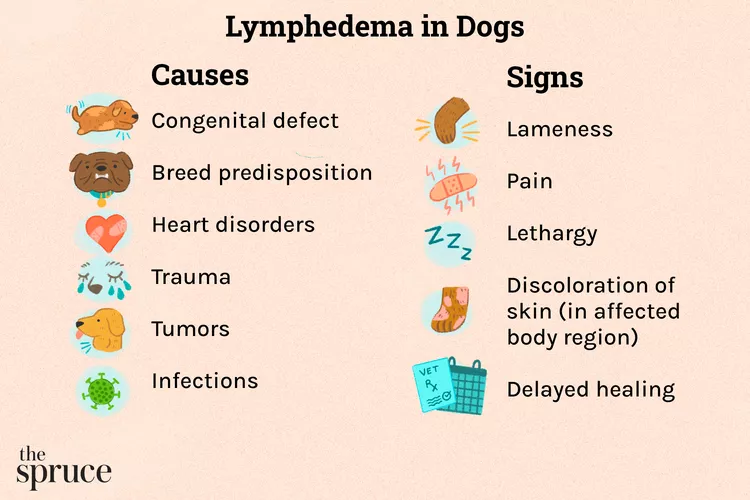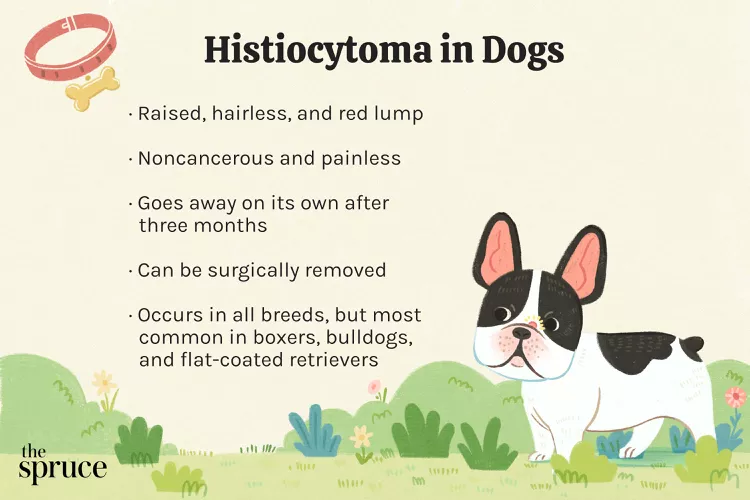
Lymphedema is a medical condition in which localized fluid retention and tissue swelling are caused by a compromised lymphatic system. The swelling may affect one or more limbs and typically begins at the end of the limb, slowly moving toward the torso. Most of the time, the cause of a dog's lymphedema is an illness or injury. Stings from insects or snake bites are common causes of lymphedema, which can affect all dog breeds and ages. Primary lymphedema, a congenital issue, is more common in certain breeds and generally appears early in a puppy's life.
Lymphedema is a collection of lymph fluid in body tissues due to obstruction within a dog's lymphatic system. This system filters blood, circulates lymph, and drains excess fluid from tissues. Lymphedema essentially refers to swelling in one or more parts of a dog's body that is caused by a problem within the lymphatic vessels.
Swelling is an obvious sign of lymphedema. While other injuries may cause tissue swelling, this condition happens as a result of lymphatic fluid pooling in parts of a dog's body.
The areas of swelling generally feel soft and malleable because they are fluid-filled—almost like a water balloon. In addition to visible swelling, the dog may begin to exhibit other symptoms that are caused by fluid retention in the swollen limbs such as pain or lameness of one or more limbs and lethargy due to generally feeling unwell.
Lymphedema is most often a secondary condition resulting from a chronic illness or an acute injury such as:
These problems can cause excessive fluid production that overwhelms the lymphatic drainage system and creates swelling.
More rarely, lymphedema can be a primary problem that appears in puppies under two months of age due to a congenital defect in which normal lymph vessels are absent or compromised.
Lymphedema can occur in any dog, but the breeds that are more predisposed to the primary condition are Borzoi, bulldogs, poodles, Labrador retrievers, German shorthaired pointers, and English sheepdogs.
Your veterinarian will start by performing a thorough exam and obtaining a history of your dog. When giving the history of your dog, be sure to include any possible injuries or interactions with insects and snakes that may have recently occurred.
Your vet will most likely perform several diagnostic tests to explore common causes of tissue swelling such as injury, heart disease, or infection. Tests will most likely include a complete blood count, tests for tick-borne infections and heartworm disease, evaluations of liver, kidney, and pancreatic functions, electrolyte tests to check for dehydration, and a fine needle aspirate of the affected area or nearby lymph nodes.
A fine-needle aspiration (FNA) may be performed by collecting cells from an affected area or lymph node and then transferring them to a slide to look at under the microscope. It is minimally invasive and can be done on the same day as your initial exam. If the FNA is inconclusive or reveals no cancerous or inflammatory cells, x-rays or an ultrasound may also be recommended.
If primary lymphedema is suspected, lymphangiography may be considered. In this procedure, dye is injected below the swollen areas, and the flow is observed through video X-rays (fluoroscopy) to reveal areas of poor circulation.
If your vet finds an underlying cause of your dog's lymphedema that is treatable, then lymphatic swelling will resolve with treatment. Resting the dog and massaging the affected limb may improve lymph circulation.
In some cases of primary lymphedema, the use of long-term pressure wraps and physical therapy can help improve a dog's quality of life. Surgery may also be recommended, based on the results of lymphangiography.
Prevention of lymphedema is only possible in cases that involve injury or encounters with stinging insects or snakes. Even then, accidents can happen, and lymphedema may occur.
If the underlying cause of lymphedema is found and treated, the condition will likely resolve when the underlying problem improves. Prognoses for primary lymphedema are more variable and guarded, and severe cases can be fatal.

Cute Pictures & Facts About Calico Cats & Kittens
Learn fascinating facts about calico cats, including photos, the genetics behind this color combination, and common folklore and traditions.
How to Prevent Cat Separation Anxiety During Vacations
Discover why cats develop litter box problems and cat behavior problems when you go on vacation and what you can do about it to help them.
Cat Behavior Changes That Might Mean Something's Wrong
Cats' behavioral changes may indicate problems—or they may mean nothing at all. Explore causes of odd behavior and what to do about them.
Lhasa Apso: Dog Breed Characteristics & Care
The Lhasa apso is an ancient breed from Tibet that was bred to be a watchdog. Learn about its history, health, exercise needs, and more.
Reasons Why Dogs Run Away and How to Stop It
Dogs can escape, especially if they’re bored and not properly contained. Here are some techniques for stopping your dog from running away.
Can Dogs Get Depression? How to Help Your Sad Dog
Can dogs get depression? Learn about the signs of depression in dogs and find out how to help your sad dog.
How to Stop Aggression in Dogs
Dog aggression can be a serious behavior issue for pet owners. Learn how to stop aggression in dogs before someone gets hurt.
How to Stop Your Dog From Growling
A growling dog can soon become even more aggressive. Reduce the noise and potential for a dangerous situation with some of these techniques.
Why Do Dogs Dig Holes? How to Stop Your Dog from Relandscaping Your Yard
Dogs have been digging holes for centuries and for many reasons. Whether they’re bored or want to cool off in the dirt, here are the top reasons why dogs dig holes.
Dog Treat Varieties
Learn about the different types of dog treats on the market and decide which are best for your dog.
Can Dogs Eat Asparagus?
Dogs can eat asparagus, provided the vegetable is cooked plain and cut up for them. Seasonings, salt, and butter make it unhealthy for dogs.
Histiocytomas in Dogs
A histiocytoma is a type of benign (non-cancerous) skin lump that usually affects young dogs. Learn the causes, treatment, and prevention.
Why Is My Dog’s Eye Swollen?
If your dog's eye is swollen, she may need veterinary attention. The inflammation could be caused by allergies, an injury, or even a tumor.
Common Bugs and Parasites Found on and Inside Dogs
Learn about common types of parasites in dogs. Find out how to treat and prevent parasites to keep your dog, your family, and yourself safe.
Exploring the Different Types of Pet-Friendly Beaches
Are you looking for pet-friendly beaches? Learn about the different types of pet-friendly beaches, their locations, and tips for visiting them with your pet.
10 Obscure, Little-known Canine Facts in Honor of National Dog Day
With National Dog Day upon us, it's time to celebrate everything about our favorite pets—even the weirder stuff. Here are 10 obscure facts about dogs you probably didn't know.
Kitten Development From 3 to 6 Months Old
Kittens grow and change a lot during their first year. Find out what happens between the ages of three months and six months old.
95 Siamese Cat Names
Our list of Siamese cat names has diverse and fun options to help you choose the ideal moniker for your elegant and lovable feline companion.
What to Buy for Your New Cat: A List of Essentials
Before you bring your new cat or kitten home, there are a number of things to collect or buy so your cat will feel welcomed like a family member.
The 6 Best Cat Nail Clippers of 2024 for a Safe Trim
Clipping your cat's nails can save your furniture and keep your kitty comfortable. We asked veterinarians for their cat nail clipper recommendations.